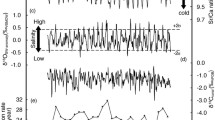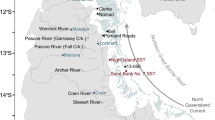Abstract
The eastern Pacific warm tongue is a region of stable and elevated sea surface temperature (SST) located just north of the equator in the eastern Pacific. This warm water mass is thought to influence the position of the Intertropical Convergence Zone (ITCZ) in the eastern Pacific and to directly influence climate in Central America. To assess the use of corals in the development of paleoclimatic reconstructions in this region, we have developed oxygen isotope (δ18O) time-series from multiple specimens of the massive coral Porites lobata collected at Clipperton Atoll (10°18′N, 109°13′ W). Six near-monthly δ18O records from different sized (age) colonies where produced for the interval 1986–1994, and three of these were extended back to 1969. All corals sampled were found to contain numerous fish-grazing skeletal scars (∼0.5 mm deep scallop shaped hiatuses). Samples collected at 1 mm intervals showed anomalous 18O/16O in the area of a bite scar, with 2 to 2.5 mm sampling intervals (10–12/year) minimizing these effects. Our results show that the average δ18O disequilibrium offset (vital effect) from equilibrium seawater composition for individual corals can vary by up to 0.4‰. However all δ18O results suggest that the vital effect offset is constant over time. Similar “offsets” are observed in the tops of old (age=∼100 y) and young (age=∼10 y) colonies, further suggesting that the biologically mediated vital effect offset does not change as a Porites colony ages. A 6-coral average composite δ18O record was constructed from 1985–1994 and a 3-coral average δ18Oanomaly record was constructed from 1969–1994. Regression analysis between monthly SST and the 6 coral average δ18O records yields an r 2 correlation of 0.54 (individual r 2-values ranged from 0.27–0.55). The 3 coral δ18Oanomaly average record has an even lower correlation to SST, with an r 2 of 0.40. Potential causes of the only moderate correlation to SST are explored and we find that inferred salinity effects, fish grazing scars, and slight chronology imperfections have all contributed to a reduced correlation to SST. Nevertheless, all El Niño events in this time period appear to be recorded by coral skeletal δ18O.
Similar content being viewed by others
Author information
Authors and Affiliations
Additional information
Accepted: 10 June 1998
Rights and permissions
About this article
Cite this article
Linsley, B., Messier, R. & Dunbar, R. Assessing between-colony oxygen isotope variability in the coral Porites lobata at Clipperton Atoll. Coral Reefs 18, 13–27 (1999). https://doi.org/10.1007/s003380050148
Issue Date:
DOI: https://doi.org/10.1007/s003380050148




